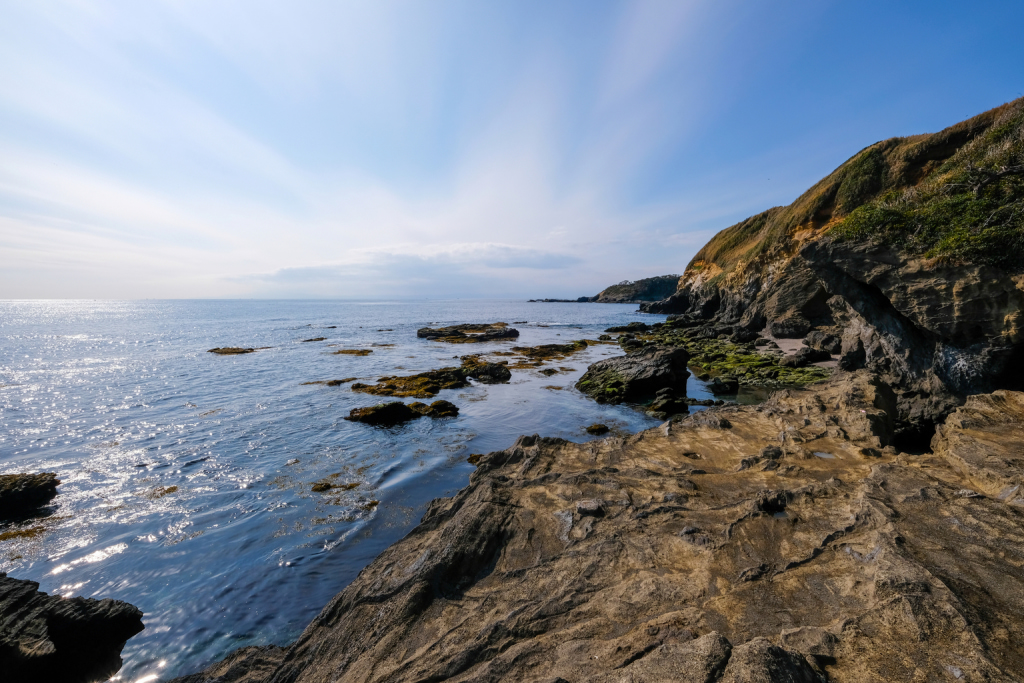On the tip of the Miura peninsula, past Kamakura and Hayama, lies Misaki and the small island of Jogashima. Just an hour or so from Shinagawa station, the area is famed for its seafood and wonderful views – our writer took a day trip to find out what all the fuss is about…
By Robert Morel
Sitting at the southern tip of Kanagawa’s Miura Peninsula, the town of Misaki and nearby Jogashima Island offer up stunning views, some of Japan’s freshest tuna – locals proudly call the town the ‘city of tuna’ – and just enough adventure to keep things interesting. The area, about an hour and a half south of Shinagawa, makes for an excellent day trip out of Tokyo. Visit the fish market and shops of Misaki in the morning, and explore Jogashima’s otherworldly coastline in the afternoon.
Misaki is a tuna-lover’s dream. While the ships coming into town have all kinds of seafood, Misaki is best known as a major tuna port. According to the locals, the tuna here puts that of Tsukiji to shame and while the claim may be a reflection of local pride as much as quality, Misaki’s seafood is incredibly fresh.
A good first stop is the Urari Seafood Market (open 9-5) for a look at the local catch and a mid-morning snack. After the market, it’s worth taking a stroll through the town’s two main shopping streets, the Shitamachi Shotengai and Misaki Ginza. While not necessarily scenic, both have a charming retro atmosphere and some interesting shops, such as the Miura Glass Studio Kirari, where adults and children alike can try their hand at making their own glass art and accessories.
For lunch, Misaki has no shortage of options – provided that you like seafood. In town, Sanwa and Showamaru have a good reputation for quality. Alternatively, take the bus across the bridge to Jogashima for lunch at Shibuki-tei, which combines two of the area’s specialties, tuna and squid. The open, no-frills interior only adds to the restaurant’s port-town atmosphere. For a post-lunch break, swing in a hammock at the Misaki Siesta Savori Club or grab a coffee at Misakipresso.
For all Misaki’s charm, the real draw to the area is Jogsshima. While Masaki’s streets and shops give the feeling of being in another time, Jogashima’s ocean panoramas and strange, rocky beach are like another world. Even in the small area of shops near the island’s western edge, things are quiet. According to a local shopkeeper I meet, tourists come in July and August, but he stresses that it can be a lonely place for locals come winter. Even on a Friday afternoon in early June tourists are scarce – a few couples, a TV crew on a location scout, a pair of hikers.
Down a narrow street lined with tiny shops selling local akamoku seaweed, souvenirs and trinkets, and up a flight of stairs is the Jogashima Lighthouse. Built in 1870 and designed by French engineer Leonce Verny, at 80 meters above sea level the lighthouse’s observation deck offers stunning views of the sea to the west. From the lighthouse, two paths snake around the southern shore of the island.
The coastline here is made of rocky crags and plateaus, caves and fingers of rock jutting out into the water. In spite of its jagged ups and downs, the coast has a welcoming feel to it. A few fishermen cast their lines from distant outcrops while an old man gathers akamoku at low tide. While it may be lonely in winter, in summer it is relaxing, peaceful and more than a little mysterious. This unique southern stretch of Jogashima’s coastline is the best reason to visit the island.
Of the two winding trails, the Yama-michi Course is a smooth walk overlooking the coast, but navigating the rocky shore reveals Jogashima’s hidden inlets and caves. The most impressive of the island’s rock formations, Umanose Domon, lies halfway between the lighthouse and Jogashima Park.
View Miura port and Jogashima island in a larger map
This marks the end of the low coastal path, but a set of stairs leads up to the Yama-michi and on to the park at the eastern end of the island. Here there more observation spots – looking from the park’s eastern tip you can see out to southern Chiba on a clear day. There is also a grassy picnic area that makes for a nice rest. It takes under an hour to walk the southern coast from the lighthouse to the eastern tip of the park, but twice that to explore the coastline and appreciate the island’s views.
But even after hiking around the island, Jogashima has one last spectacular view in store. The sunsets from the western tip of the island are stunning, and there is no better place to witness one than soaking in the outdoor batch at Jogashima Keikyu Hotel.
An easy day trip from Tokyo, Misaki and Jogashima are a refreshing escape from the city. The mix of small-town sightseeing, exploring the coast, and excellent food make it a good trip for friends, couples, families, or even solo travelers.
How to get there:
Take the Keikyu Line from Shinagawa to Misakiguchi Station and get on a bus. For Misaki, take a bus to Miaski-ko and for Jogashima, take the Jogashima bus to the final stop.
Misaki Maguro Ticket
To get good value out of your day get Keikyu’s special “Misaki Maguro Ticket.” For ¥2,980 this covers round-trip train fare from Shinagawa, bus travel in the area, includes a tuna set lunch at one of many participating restaurants, and a free pass to an area entertainment (including the Jogashima Keikyu Hotel outdoor bath).
Main Image: kazu8 / Shutterstock.com









